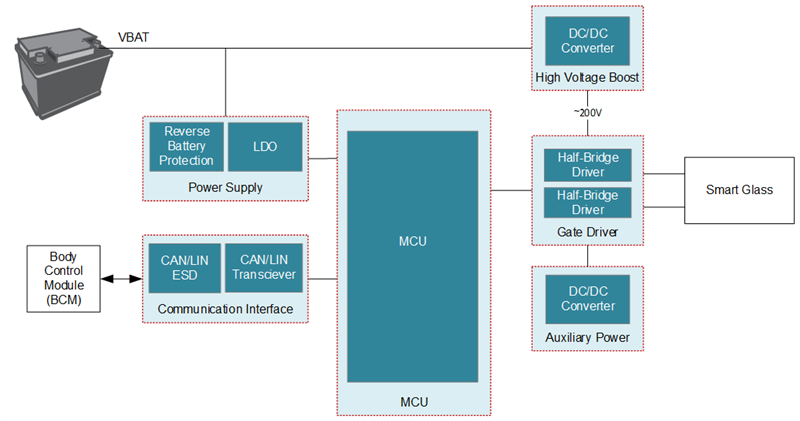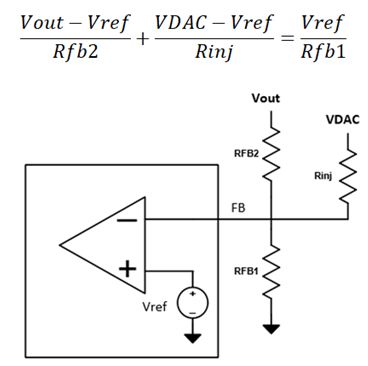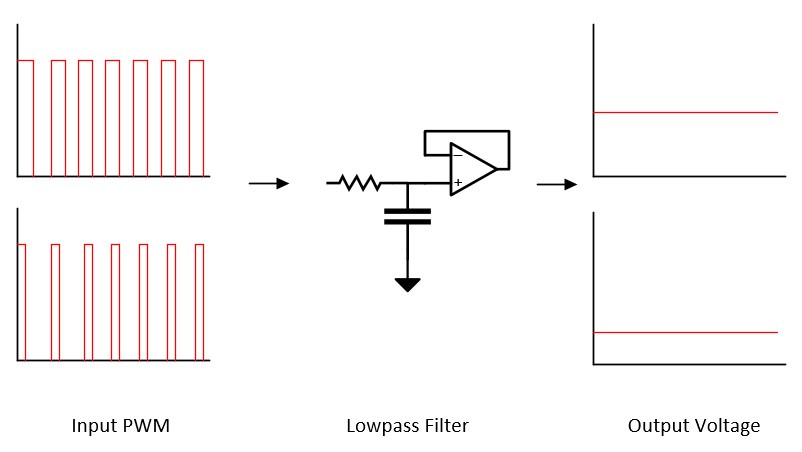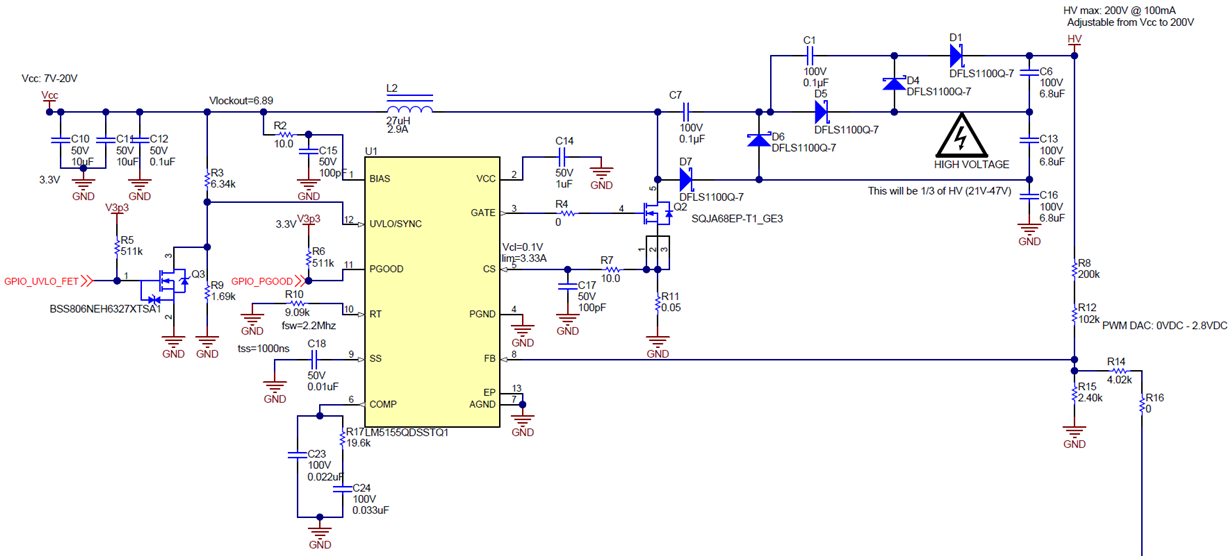SSZT557 january 2019 LM5155-Q1 , UCC27712-Q1

Sunroof and automotive window tinting is now a programmable feature thanks to new technology making its way into future vehicles. At the flip of a switch, you can now block out the light coming through your car’s sunroof or enjoy the stars during a night drive.
A manufacturer called Research Frontiers created electrically tint-able glass with SPD-SmartGlass technology that works by aligning nanoparticles in a film within glass, plastic, acrylic or chemically strengthened glass. This glazing can block heat, sunlight, glare from ultraviolet rays and noise. SPD-SmartGlass enables instant and precise control of the level of light coming into a vehicle by varying the amplitude of the voltage applied to the glass.
To drive this dynamic glass requires a high-voltage AC signal in order to rapidly orient light-blocking nanoparticles.
The smart sunroof design provides a wide array of benefits for passengers inside the cabin. In a tinted state, it reduces heat transfer and prevents glare, and in both tinted and clear states it reduces ultraviolet and infrared light. Having control over the tinting level allows users to adjust these conditions for the environment at hand.
Generating the necessary high-voltage AC signal to control the tint level in a car is challenging because cars do not have an AC voltage source readily available. Rather, the AC voltage signal needs to be generated using a power-inverter circuit that converts the DC voltage of an automotive battery into an AC voltage.
Our automotive SPD-SmartGlass driver reference design shows one way to convert DC to AC power. Two core components in this design are:
- A boost converter to step the low-voltage automotive battery DC to a high-voltage DC.
- A full-bridge driver to convert the DC signal to an AC signal.
From there, a square wave, sine wave or other periodic waveform can provide power for the glass.

 Figure 1 Figure 1 Is a Block Diagram of
the Reference Design, While Figure 2 Shows How the Voltage Is Controlled in
These Intermediate Steps to Result in a Sine Wave.
Figure 1 Figure 1 Is a Block Diagram of
the Reference Design, While Figure 2 Shows How the Voltage Is Controlled in
These Intermediate Steps to Result in a Sine Wave.Controlling the Smart Sunroof Tint Level
The glass tint level is directly related to the amplitude of the driving waveform. As shown in Figure 2, constantly changing the duty cycle at a sinusoidal rate generates a sine wave. After filtering, this results in a pure sine-wave output. The pulse-width modulation (PWM) duty cycle could be adjusted even further to control the amplitude of this sine wave.
To drive the FETs and ultimately the SmartGlass, two half-bridge gate drivers (UCC27712-Q1) are configured into a full bridge configuration. Due to its interlock and deadtime capabilities, the UCC27712-Q1 is used in this application to ensure both high side and low side FETs are never on at the same time.
Controlling the feedback pin of the high-voltage DC/DC boost manages the supply of the full bridge. By using an injection resistor connected to the FB pin of the LM5155-Q1 boost converter, a DC voltage (represented by the node VDAC in Figure 2) can manipulate the LM5155-Q1 output voltage and in turn increase or decrease the boost voltage.
 Figure 2 Injection Resistor for Voltage
Output Manipulation
Figure 2 Injection Resistor for Voltage
Output ManipulationThe VDAC voltage is produced by filtering a PWM signal from the microcontroller with a resistor-capacitor (RC) filter and buffer, creating a PWM digital-to-analog converter (DAC). Figure 3 illustrates how different PWM duty cycles and a RC-buffer circuit can generate different DC voltage levels for use in the fuse-block injection circuit.
 Figure 3 PWM DAC signal chain
Figure 3 PWM DAC signal chainGenerating high-voltage DC signal
Another unique feature of the reference design is a charge-pump voltage tripler connected to the boost converter, as shown in Figure 4. The charge pump triples the voltage output of boost converter to enable the generation of a 200-V supply without the need for a large and expensive transformer-based power circuit.
 Figure 4 Charge-pump Voltage
Tripler
Figure 4 Charge-pump Voltage
TriplerA benefit to this method of generating 200 V is that the switching metal-oxide semiconductor field-effect transistor (MOSFET) Q2 in Figure 4 will only need to be rated for the voltage seen across the bottom output capacitor, C16. This allows you to use lower-cost and lower-voltage-rated components in your design instead of components with greater than 200 V.
As the power and voltage ratings for the MOSFET increase, the gate and drain capacitances also increase. These capacitances lead to slew-rate and rise-time issues when trying to control the MOSFET at 2 MHz, so lower-voltage requirements make finding a MOSFET with appropriate input and output capacitances easier.
The charge pump also reduces stress on the switch node. In order to step up from around 10 V to around 200 V, very high duty cycles are required at the switch node, leaving very small off-times and putting a lot of stress on the boost converter. Since the charge pump reduces the voltage that the converter sees by one-third (at the cost of 3x the output current), the duty cycle and off-time requirements are significantly reduced.
Conclusion
A smart sunroof increases comfort levels in the cabin and allows for a better, more comfortable driving experience. Innovations with our electronics help you accelerate the process of making this new technology an important part of smart driving in the future.